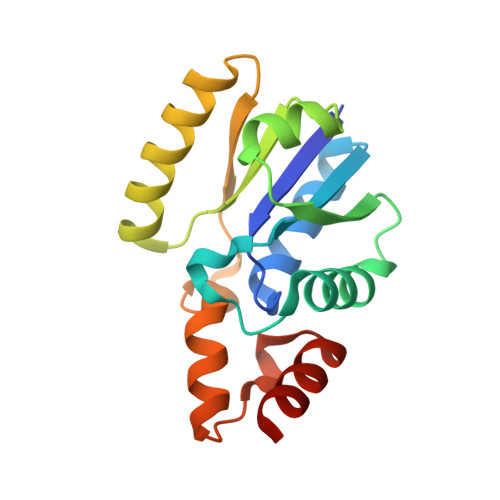Discovery and Optimization of Phosphopantetheine Adenylyltransferase Inhibitors with Gram-Negative Antibacterial Activity.
Skepper, C.K., Moreau, R.J., Appleton, B.A., Benton, B.M., Drumm, J.E., Feng, B.Y., Geng, M., Hu, C., Li, C., Lingel, A., Lu, Y., Mamo, M., Mergo, W., Mostafavi, M., Rath, C.M., Steffek, M., Takeoka, K.T., Uehara, K., Wang, L., Wei, J.R., Xie, L., Xu, W., Zhang, Q., de Vicente, J.(2018) J Med Chem 61: 3325-3349
- PubMed: 29551072
- DOI: https://doi.org/10.1021/acs.jmedchem.7b01861
- Primary Citation of Related Structures:
6CHL, 6CHM, 6CHN, 6CHO, 6CHP, 6CHQ, 6CKW - PubMed Abstract:
In the preceding manuscript [ Moreau et al. 2018 , 10.1021/acs.jmedchem.7b01691 ] we described a successful fragment-based lead discovery (FBLD) strategy for discovery of bacterial phosphopantetheine adenylyltransferase inhibitors (PPAT, CoaD). Following several rounds of optimization two promising lead compounds were identified: triazolopyrimidinone 3 and 4-azabenzimidazole 4. Here we disclose our efforts to further optimize these two leads for on-target potency and Gram-negative cellular activity. Enabled by a robust X-ray crystallography system, our structure-based inhibitor design approach delivered compounds with biochemical potencies 4-5 orders of magnitude greater than their respective fragment starting points. Additional optimization was guided by observations on bacterial permeability and physicochemical properties, which ultimately led to the identification of PPAT inhibitors with cellular activity against wild-type E. coli.
Organizational Affiliation:
Novartis Institutes for Biomedical Research, 5300 Chiron Way , Emeryville , California 94608 , United States.


















